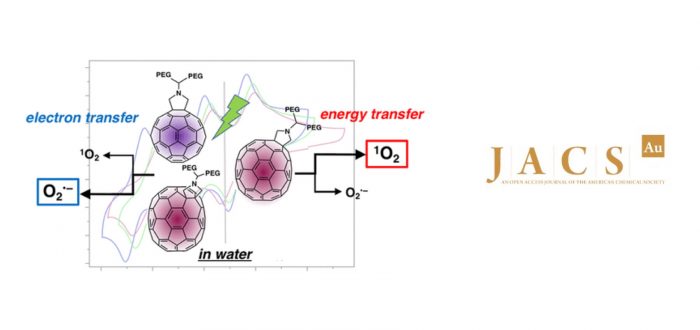Well-defined fullerene-PEG conjugates, C60-PEG (1) and two C70-PEG (2 and 3 with the addition sites on ab-[6,6] and cc-[6,6]-junctions), were prepared from their corresponding Prato monoadduct precursors. The resulting highly water-soluble fullerene-PEG conjugates 1–3 were evaluated for their DNA-cleaving activities and reactive oxygen species (ROS) generation under visible light irradiation. Unexpectedly, photoinduced cleavage of DNA by C60-PEG 1 was much higher than that by C70-PEG 2 and 3 with higher absorption intensity, especially in the presence of an electron donor (NADH). The preference of photoinduced ROS generation from fullerene-PEG conjugates 1–3 via the type II (energy transfer) or the type I (electron transfer) photoreaction was found to be dependent on the fullerene core (between C60 and C70) and functionalization pattern of C70 (between 2 and 3). This was clearly supported by the electron transfer rate obtained from cyclic voltammetry data and computationally estimated relative rate of each step of the type II and the type I reactions, with the finding that type II energy transfer reactions occurred in the inverted Marcus regime while type I electron transfer reactions proceeded in the normal Marcus regime. This finding on the disparity in the pathways of photoinduced reactions (type I versus type II) provides insights into the behavior of photosensitizers in water and the design of photodynamic therapy drugs.
The paper has been published in the Open Access Journal of the American Chemical Society, JACS Au:
K. Liosi, A.J. Stasyuk, F. Masero, A.A. Voityuk, T. Nauser, V. Mougel, M. Solà, and Y. Yamakoshi
“Unexpected Disparity in Photoinduced Reactions of C60 and C70 in Water with the Generation of O2•– or 1O2 ”
JACS Au 2021, [], ASAP-
DOI: 10.1021/jacsau.1c00239
Girona, Aug. 31, 2021
For more info: gestor.iqcc@gmail.com

